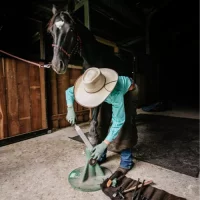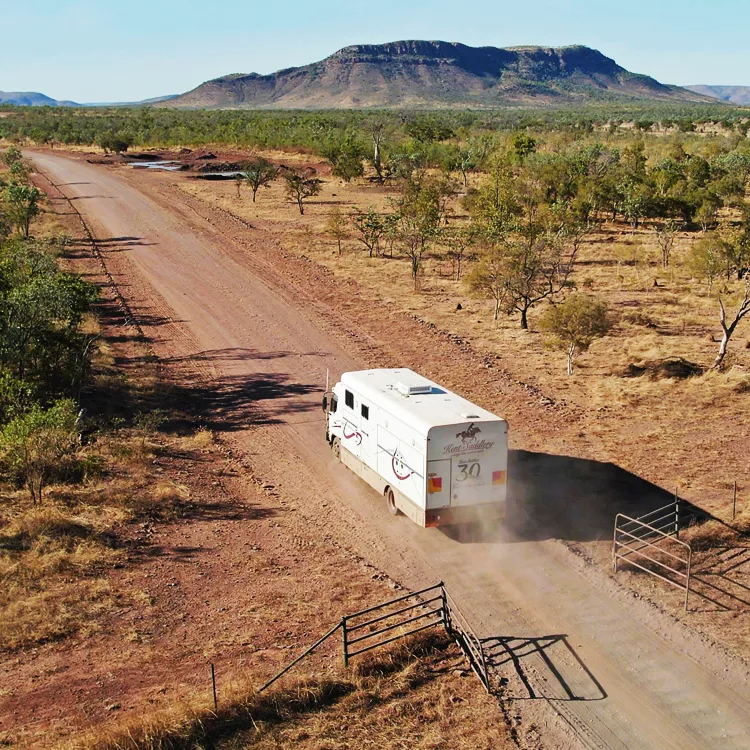Spring Creek Station, East Kimberleys,WA – Mike and Jane Shaw
“The old fashioned way”
On January 10, 2002, Mike and Jane Shaw settled at Spring Creek Station on the Duncan Road, which winds its way in and out of the NT/WA border. Mike thrives on WA time and the extra early morning starts to the day. When asked what it is about Spring Creek that he likes, Mike is adamant, “Definitely not the rocks!” and then adds, “It’ll do me! It’s a one family place, hands on, I can manage everything myself and its good, I like it.” The Station is currently fully stocked with six thousand head of cattle, and sixty horses.
When they first arrived, Mike and Jane wondered what on earth they’d done, “things were tight, it was scary that first year. Now I never look back, you know.”
Prior to Spring Creek, Mike had spent twenty years at Moola Bulla Station, near Halls Creek in the East Kimberleys and Jane had lived there for ten years. During that time Mike’s philosophy regarding stock handling, people, and work, was continually moulded and challenged by the country, the cattle and horses, and the people with whom he lived and worked. It’s a legacy that’s determined the way he operates his own place, and there’s no disguising Mike Shaw’s enthusiasm regarding the benefits of “old fashioned” methods.
Mike’s childhood was spent at Rockhampton, Qld; his Grandparents had properties and he’d “go out there all the time”. He attended Emerald Pastoral College, Qld, passing with an Honours Certificate in 1979. For two and a half years he worked at Springsure for David and Robyn Arthur, “a very smart man”, and then he put in a season at Marion Downs, Boulia, Qld. He was told about Moola Bulla, and in 1982, that’s where he went.
“Nothing much had changed since the turn of the century, ya know? Moola Bulla was still operating “in the old fashioned style”, with two mustering camps of eight or nine workers. Everything was walked, horses and cattle; no trucking. We didn’t muster a whole paddock in one big hit. We’d go out this way today, that way tomorrow, overlapping each muster until we’d end up with say, four or five hundred head. We’d draft them up, put them into their paddocks, then go out again. We’d pull the calves off, keep them in the yard, let them out for a drink, then back in the yard.” Bronco branding (the traditional branding method) was being phased out when Mike left Moola Bulla.
By 1991, Mike had been at Moola Bulla for nine years, six of those as Head Stockman. He thought, “This is no good. I’m risin’ twenty eight. I gotta get a better job than this! We didn’t know what was going on in the world… didn’t even know who the Prime Minister was. I could see myself as one of those old broken down ringers who know nothing else but stock work.”
He went to see Dick Northcote, the owner, to tell him he was “moving on, and old Dick, he says “I’ve been meaning to talk to you about this!”” Dick bought a helicopter, and offered to pay for Mike to get his chopper licence. Mike had a good think about it… “these things (helicopters) seemed a bit dangerous,” but reassured by other pilots that thorough maintenance assured safety, he went ahead with the proposition.
From then on, he became half Overseer, and half Pilot / Head Stockman. Dick Northcote phased Mike in, and himself out, and Mike was fully Manager by 1994, a position he held until Moola Bulla sold in 2002.
In 1992, Jane Leishman arrived at the Moola Bulla stock camp to start work as a jillaroo. She’d come from a family farming background at Geraldton in the south of WA, and she’d attended Cordelia College, WA, where horse riding was a major part of the curriculum.
Jane probably kept her thoughts to herself when she first met Mike Shaw, the Overseer. He leaped out of the truck, and she thought, “This is the Overseer?… this rough looking bloke, wearing dirty jeans and a football jersey?” Her first impressions weren’t all that good. Mike reacts, “What did she expect? This was the Kimberleys, not a bloody sheep station!” Mike continues, “We didn’t have many jillaroos back then, just the odd one… conditions were too rough. We camped out for two to three months at a time; transport was tractors pulling the camp trailers.” (See Nita Downs story)
Mike and Jane started going out at the end of the year. Mike teases, “No good to me if they can’t prove themselves in the camp, eh? Gotta check them out a bit, ya know… make sure they can handle the work! I think I won her heart when I Slew into camp one day and she was having trouble shoeing her quota of horses. I quickly raced in there, shod her horse and Slew out again. He grins; “I think she thought… “My hero!”…. She’s a very good rider you know, showjumping and dressage.”
Time passed, and Jane informed Mike, “You’re a woeful looking rider… you need to ride neatly!” The comment met with a predictable reaction, “RIDE NEATLY?!!… if a horse drops its head, and it’s bucking where’s the time to ride neatly?” Mike admits, “Made me feel about this big.” However, he agreed to go to a professional riding instructor in Perth, “there’s more to it than you think you know; learning to ride with balance, we cut 75% of horses’ sore backs in the camp, just like that!”
At Spring Creek, Mike and Jane have a line of Thoroughbred horses, with Moola Boola bloodlines. “Our Kent Saddles have an extra high gullet… I like a good traveller; can’t stand a jig, jig, jig! At Moola Bulla we’d have the two stock camps of eight or nine blokes, and each bloke had five horses. At the start of the year the old horses were for the new blokes, the colts for the blokes coming back from last year. So, that was forty to forty-five horses, and they were expected to work ten weeks. Of course, at six weeks most of the shoes were off, and we’d have to reshoe them to take them through to ten weeks. Then, we’d get a fresh plant… Three or four times a year we’d change the horses. Nothing was fed; we relied on numbers. The horse work, it was hard… breaking in thirty to forty horses; I’m glad I did that. When I left Moola Bulla, there were four hundred and fifty horses, and two hundred and fifty were workers.”
Mike remains dedicated to the old ways. “We still do things here fairly old style. Let’s face it, I’m a cow and calf man. I prefer to work with small mobs. If you’ve got a maximum of two hundred cleanskins (unbranded cattle) in a mob, you won’t mess with mothering up. I hate seeing a calf mismothered. Every animal counts! I also walk the cattle everywhere… no trucks.”
“And helicopters? They’re bloody good things. They can gather cattle in three hours when it would take a stock camp three days. However, its against my religion to put cattle into a yard with a chopper! Once the cattle are blocked up, I tell the chopper pilot to go and land – let the people on horseback take over and get them into the yard. Looking at the economics of it, I reckon what you gain in speed with choppers you lose in mismothering, and the cattle are never as quiet. Fifty, sixty years ago with horses, you’d be always looking out for the aged cows with calves, and drop them off as you went along. “Hayley Easter, one of the Spring Creek stock camp team, is a stock woman who, Mike enthuses “is always watching the calves, and noting which cows they belong to.” (In 2010, Hayley was awarded “Trainee of the Year” in Perth.)
In 2009, Mike was hospitalised in Darwin with a broken leg. Three young ringers, Hayley Easter, Darcy Stace, and Matilda Huber rode their horses for the first muster of the second round. The chopper pilot reported to Mike that, “It was the best bit of stock work he’d seen all year.” Mike agrees, “they’re good, you know, a good crew.”
Mike emphasises the importance of training and keeping good staff. “I put a lot of time into my staff… you’ve gotta keep some of them coming back. I’m not a real good people person; I’ve had to develop people skills.”
“At Moola Bulla, fifty percent of workers would come back. (Damian Forshaw being one such worker – see Nita Downs story.) It was exciting, hard work; it was good! Mike is on a roll. “There’s a lot of whinging these days about not being able to get good workers. You need to give ’em the kind of work where they learn some skills. That’s another thing against my religion… laneways… wrecks good young people; they have no idea of working a mob! NO good, Nope.” Apart from wanting to do things “the old fashioned way”, Mike and others like him are convinced that young people experience much more job satisfaction when they’re actually working the cattle, riding the horses, learning stock handling skills. “There’s big mobs of just yard work… only needs labourers, not ringers.”
Since 2007, Jane has been spending some time away each year with the Shaw children, William and Sally; for the purpose of schooling, and to encourage them in their impressive progress with showjumping and dressage. They have both competed at National level, and at age eleven, Sally is able to execute a flying change, and looks to keep advancing in the discipline. William (12) is at boarding school in Perth, and Mike proudly explains, “is getting into rugby… that’s my boy!”
Since 2002, Mike and Jane Shaw have worked with diligence and determination to achieve the best outcomes for their family, the staff, the livestock and the country at Spring Creek Station. Their energy and vitality is inspirational and Mike explains, “Tell you what, I was married at thirty-three, William was born when I was thirty-five. You set the example, keep lively for your kids, and it’ll be in them too. You want them to have a good work ethic, I say to them, “C’mon, get going!””
There’s no doubt the Shaws will continue to lead a productive and focused lifestyle; Jane committed to excellence in the field of horsemanship, and Mike to the cattle industry. The days of bronco branding and camping out for months at a time may be over, but at Spring Creek Station, Mike Shaw will remain unembarrassed and vocal about doing things “the old fashioned way”.















